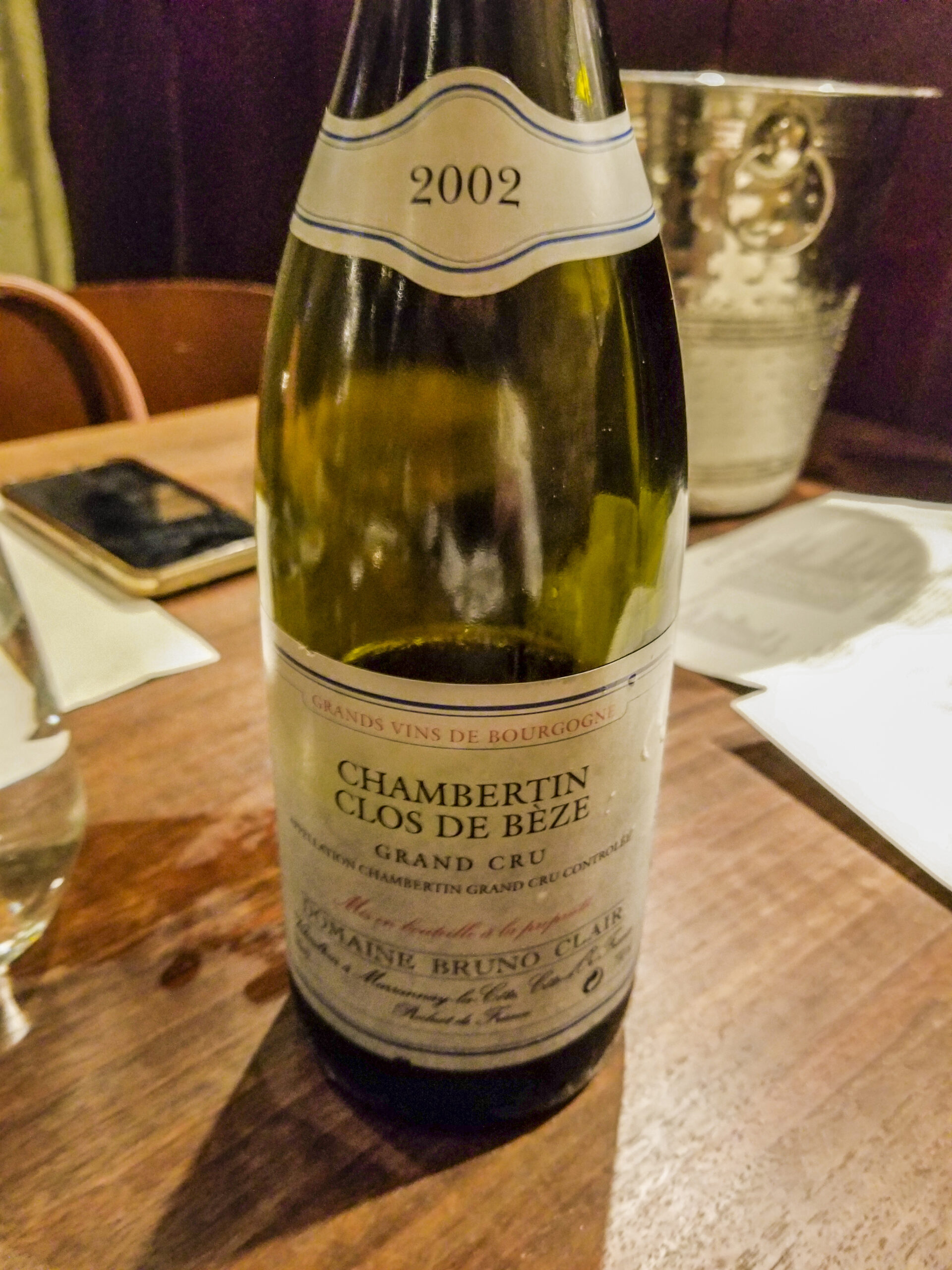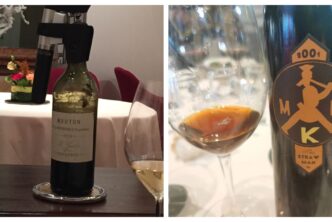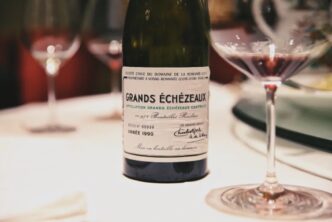Bruno Clair 2002 Chambertin Clos de Bèze 97
by Robert Millman

Having recently tasted the 2002 Clos de Bèze from Bruno Clair, I decided to put pen to paper, as it were, to describe the experience of this formidable wine. Clos de Bèze is the northern part of the Grand Cru called Chambertin Clos de Bèze. The Clos de Bèze is the smaller and by far the older portion of the entire Grand Cru area. The monastery of Bèze, north of Dijon, received a donation of existing vineyards here shortly after its foundation in in 630 AD. Long run as a monastic property, in 1219 it passed to the canons of Langres, who remained in charge until 1789 and the French Revolution. More importantly, the 14.7-hectare site was planted to Pinot Noir by the Cistercian nuns of Notre Dame de Tart, and the vineyard has a halo of sacredness about it unique to the vineyards of Burgundy. When you visit the vineyard–planted 1500 years ago! —you have the uncanny feeling that this is God’s terroir.
As far as I am concerned (and not just me, I’m in evry good company), of the twenty-one red wine Grand Crus four constitute la crème de la crème: Romanée-Conti, Musigny, La Tâche and Clos de Bèze. I will not attempt a personal ranking of the four. I will say that, for me, Clos de Bèze is the most profound and in many ways the most difficult to grasp of the four. It seems altogether appropriate that a wine with sacred origins should not reveal its secrets so readily. Unlike the Grand Crus (and several Premier Crus) of Vosne-Romane which exude a sexy, sensual perfume which is all but irresistible, Clos de Bèze shrouds its deep, dark fruits and earthiness in a cover of iron and tobacco. It takes work to get to the bottom of the glass! This combination of power, authority and introversion renders a well-made Clos de Bèze among the most challenging wines to fathom. It is a wine which must be met on its own terms.
Bruno Clair is fortunate in owning nearly a hectare of the Close de Bèze. His vines were first planted in 1912 (with renewed plating in 1972) and his continuous holding captures the upper and lower terroirs of the site. The best terroirs in Burgundy are really a mosaic of geologically differentiated sub-terroirs. It is the work of the best vignerons to integrate these differences into an integrated whole. In my view, it is Bruno Clair, along with Domain Rousseau, which makes one of the two best expressions of this mighty vineyard. Clair uses up to 30% whole clusters and ages his wine in barrel (30% new) for eighteen months before bottling unfined and unfiltered. Nothing flashy. Let me quote from Clive Coates’ magisterial book The Wines of Burgundy: “Clair is a meticulous wine maker, anxious above all for purity and elegance. These are not for those who like their Burgundies sweet, syrupy and fat.” Indeed. I might add that those who like traditional Barolos will feel right at home tasting a Bruno Clair Burgundy.
The 2002 vintage has proved to be something of a puzzle. The white wines were bursting with fruit and spice but quickly oxidized during that terrible decade (roughly lasting from 1996 through 2006) for white Burgundy. The 2002 were full of promise: Less rich and sugary than the delicious 1999s, but with excellent definition and balance. Alas, many have not lived up to their original promise. Some, like Bruno Clair’s Gevreys have dome beautifully. The 2002 Clos de Bèze in the glass was almost inky-dark with a hidden aspect that carried right through to bouquet, taste and texture. The nose was smoky, leathery, dark fruited and powerful but without being especially expressive. On the palate the wine was of such density and proportion as to require a glass twice the size of the ones we used. Interestingly, throughout the two hours of tasting it, the wine seemed to increase in inner density but not in overt expressivity. Still, this is a wine that pulls you into the glass. Tasting it relatively late at night, I had the strange sensation that I was not quite up to the demands of this remarkable wine. The 2002 Bruno Clair Clos de Bèze inspires awe rather than mere appreciation. It is almost sacrilege to have to award points to such a wine. Drinking window: now-2032
Sandrone 2016 Barolo Aleste 97+
by Ian D’Agata

One of Italy’s most famous and greatest wines, it is also the wine that put the Cannubi Boschis vineyard on the world wine map. In fact, the Cannubi cru of Barolo is a longue tongue that moves in a northeast to southwest direction and is divided into Cannubi Boschis, Cannubi centrale (my definition of it in an article I wrote many years ago for Decanter magazine), Cannubi San Lorenzo, Cannubi Valletta, and Cannubi Muscatel. Cannubi Boschis had never been much talked about, in fact it had always gone by the name of Monghisolfo dei Cannubi or Monghisolfo. But Sandrone opted for the “Cannubi Boschis” monicker (the “Boschis” most likely a reference to a family name quite common in the area) and the rest is, as they say, history. Very few wines anywhere in Italy attained the fame and fortune of this wine, and some vintages are still viewed as the best Barolos ever made: a case in point being the unforgettable 2010. However, Luciano Sandrone really desired to name the wine in honour of his daughter’s two children and the youngest members of the Sandrone family, Alessia and Stefano. The wine’s new name, “Aleste”, is therefore a contraction of the children’s two first names. The former Barolo Cannubi Boschis was renamed with the 2013 vintage (so the last time “Cannubi Bioschis” appears on the label is the 2012 vintage). The change in name notwithstanding, the wine remains much the same as it has always been: just plain great.
The Sandrone 2016 Barolo Aleste is an especially memorable version of this Barolo, one that will age splendidly and for a very long time indeed. Deep red, magically perfumed and flavoured, with very deep, multifaceted nuances of red and black cherry, sweet spices, tobacco, minerals, violet, rose petals and licorice that are nicely framed by serious but polished tannins and lifted harmonious acidity. A very deep, complex wine that is currently still very young and shut down, this tastes almost like something made by crossing the perfume of Barolo, the power of Monforte and the elegance of Serralunga, quite a feat indeed. The potential for it to turn into something absolutely unforgettable is immense. At this stage of development, it is, without question, one of the best young Barolo Aleste (Cannubi Boschis) ever made by Sandrone. It is with wines like this one that wine lovers everywhere have to be grateful Luciano Sandrone one bright day decided to leave an underachieving big winery and fly solo; in so doing, created wine history and greatness in the process. Drinking window: 2028-2050.

 English
English

